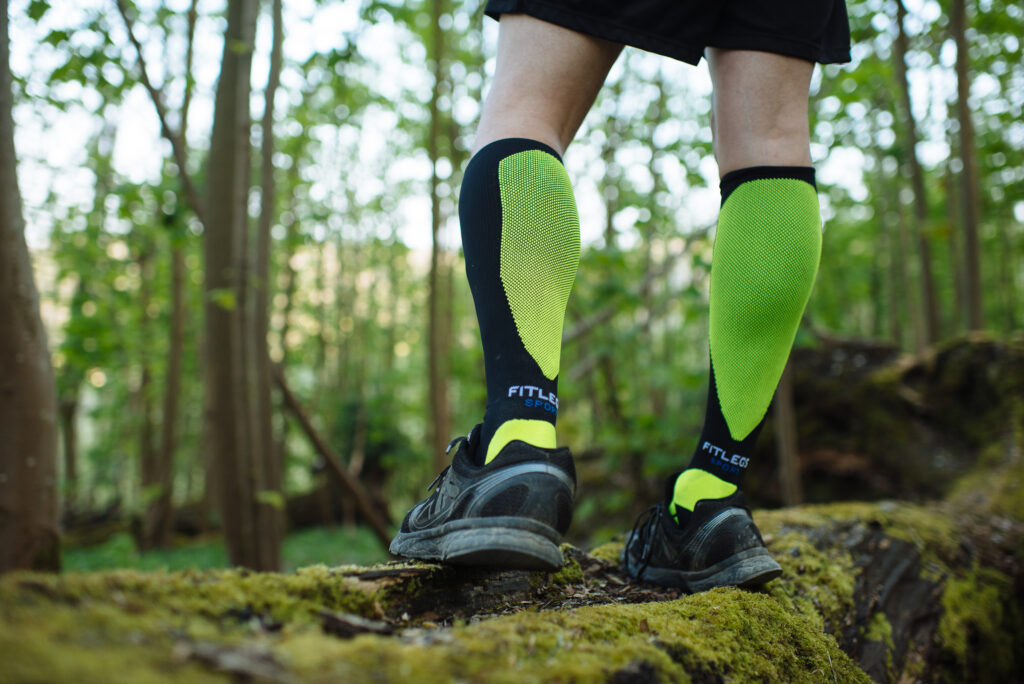Athletes of all levels have been exploring wearing sports compression socks and embracing the benefits for several years, and it’s easy to see why. Wearing compression socks can come with several benefits in various situations such as long-distance travel, demanding jobs, injury recovery and more. We’ve already written about people in different industries who would benefit from wearing compression socks, but this guide answers some of your specific questions about sports compression socks.
What are the benefits of compression socks in sports?
Compression socks bring a whole host of benefits, and the things that make them good for conditions such as DVT, edema, varicose veins and cramps, are all applicable to athletic performance.
Compression socks provide graduated compression up the leg, with the highest compression level (measured in mmHg) at the ankle and reducing as it goes up the calf. Counterintuitively, this compression helps to improve blood flow back to your heart, allowing fresh, oxygenated blood to be delivered to the legs. This can help to reduce aches, soreness and swelling, as well as improve post-exercise recovery.
H2: When should you wear compression socks for running?
When should you wear compression socks for running?
Sports compression socks can be worn both during and after any exercise. Most people associate them with endurance sports such as running but they can be used for any sport such as football, tennis, cycling etc. What’s more, many people choose to wear them when walking or hiking or even playing golf.
Any sport that uses the leg muscles could benefit from wearing compression garments. However, there is some evidence to suggest that the more ‘damaging’ or ‘impactful’ the exercise, the greater the benefit will be. This means that everyone from weight lifters to runners, and everything in between, could experience the benefits of sport compression socks.
Most people recommend having several pairs of compression athletic socks so you can wear them during as well as after exercise to aid your recovery. For more information, read our guide about how to help DOMS and post-exercise recovery.
Do compression socks help shin splints?
Compression socks may help with the treatment of shin splints, although they won’t do anything preventative. Studies show that compression socks can help runners with recovery, minimising soreness and inflammation. They can also be effective at reducing swelling in the legs. All of these benefits can help you manage the pain and discomfort that come as a result of shin splints, but they won’t do anything to heal the underlying cause. For that, you’ll need good old rest, and in severe cases, physical therapy.
Can compression socks help leg cramps?
Wearing compression socks during or after physical exercise may help prevent or reduce the severity of leg cramps, depending on the underlying cause. The compression provided helps to improve your blood flow, helping oxygenated, nutrient-rich blood to reach your legs more effectively. Not only can this help you when you’re out on your morning run, but it may help prevent the dreaded cramps and aches you might experience afterwards.
What is the best material for compression socks in sports?
What material you choose for your sports compression socks will be down to personal preference. Cotton is by far the most common option and it offers a good mix of comfort, breathability, durability and affordability. However, bamboo sports compression socks are becoming increasingly popular. Bamboo is a sustainable material that offers excellent softness and moisture wicking, as well as antibacterial and hypoallergenic properties. For more information, read our Bamboo vs Cotton Compression Socks Guide.
What level of compression should I choose for sports socks?
Sports and compression athletic socks usually fall into the low-to-medium range of compression levels at around 18-24mmHg. A lower level of compression might be preferable to amateur athletes or those who prioritise long-term comfort. However, a higher level of compression might be better suited to those who exercise more frequently or take part in higher-impact, more intense sports such as running, football, basketball or tennis.
Sports compression socks could help you improve your athletic performance and recovery. Available in a wide range of colours, materials, lengths and compression levels, you’ll be sure to find one that suits your needs. Visit the FITLEGs online shop to find our range of men’s and women’s sports compression socks.
